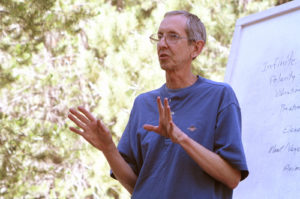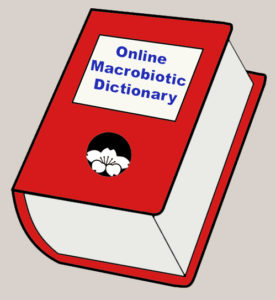
Completed Entries
Traditional Japanese stew with daikon, carrot, burdock, musubi kombu, etc.
Lightly pounded cakes of cooked sweet rice, similar to mochi.
Vegetables lightly boiled in salted water.
Unheated cooking oil used as compress for burns.
See Cautionary note.
“It is important to use quality oils and to use them in ways that are healthy. New information about fats has been discovered since the first publication of this book twenty years ago. Then, I used corn oil in baking. I don’t recommend it anymore. Corn oil requires high heat and technological processes—refinements that degrade oil’s fragile nature. In addition, oil processed from corn often comes from genetically modified (GMO) corn. Canola oil and safflower oil are inferior oils for these same reasons and should be avoided. Oil is fragile. All vegetable oils except coconut oil and palm oil denature in temperatures in excess of 240 degrees…Unrefined organic oils are preferred to ensure that no GMOs or chemicals are used. Oils that I currently recommend for cooking are light and toasted organic, unrefined sesame oil; organic extra virgin olive oil; and organic, unrefined coconut oil. Other organic and unrefined oils such as flax, avocado, or walnut are valuable used unheated in salad dressings or drizzled on food.” Basic Macrobiotic Cooking by Julia Ferré, pages 16-17.
Rice porridge with vegetables, often made with leftovers.
Soybean pulp that remains after the soy milk has been extracted to make tofu.
Beginning at age seventy, dietary suggestions include reducing salt intake, using a small amount of good quality vegetable oil daily, and making certain foods are as simple and natural as possible. Lifestyle recommendations include living more in nature and giving happiness to others.
A fundamental law of biology by which one grain planted generates ten thousand grains and by which Ohsawa encouraged people to live. “Master Ishizuka taught me macrobiotic medicine and rescued me from a mortal illness. Consequently, I dedicated my life to saving ten thousand existences as a testimony of my gratitude: ‘One grain, ten thousand grains.’ For me, ten thousand people represent the world.” Macrobiotic Guidebook for Living, 107-108.
Another name for the Infinite World or Infinity.
See Order of the Universe.
Life that follows the Order of the Universe in that everything changes from yin dominance to yang dominance or from yang dominance to yin dominance always and forever.
Macrobiotic philosophy begins with the concept that everything emanates from the Infinite (Oneness) in an orderly progression that is knowable. This progression is the order of the universe, tracing the transformation from Universal Life (the Infinite) to individual life in seven worlds or steps in which each world creates and nourishes each subsequent one. The seven worlds are: Infinity, polarity, vibration, pre-atomic, elements, vegetal, and animal. See also Seven Laws of the Order of the Universe.
- Infinite World (Infinity): The unlimited, boundless, endless, invisible, and unmeasurable primal source of all things, including humankind. Other names for the Infinite World include: Infinity, Infinite Pure Expansion, Oneness, God, Spirit, Nature, the Tao, Taikyoku, Perfect Consciousness, Ether-Universe, Instinct-Intuition, Supreme Judgment, and Seventh Heaven. Since all things and people are considered to be created and continually nourished by the same source, everyone and everything is connected.
- Polarity, World of: The foundation of the relative world due to the polarization of the Infinite into yin (expansion) and yang (contraction). These two arms are both antagonistic and complementary to each other. The interplay between them is the origin of magnetism. It is the beginning of pulsation and life itself as these two energies intersect and collide with each other. Thus, yin-yang interaction is the foundation of the finite world (worlds two through seven).
- Vibration, World of: The beginning of the production of energy and origin of electricity as yin and yang continue to interact with each other and waves such as light and sound waves are created. Antagonisms and complementaries include visible and invisible radiation, hot and cold rays, dynamic and stimulating rays (yellow, orange, red) and static and calming rays (green, blue, indigo, violet), and infrared and ultraviolet radiation.
- Pre-Atomic World: The beginning of all subatomic particles as the two arms of Oneness continue to interact not only with each other but also with the waves of the world of vibration. Examples of antagonisms and complementaries include centrifugal and centripetal force and solid and gaseous.
- Elements, World of: The world of elements evolves from subatomic particles and is the beginning of atoms, stars, and millions of solar systems. Antagonisms and complementaries include mountain and river, land and sea, air and earth, polar and tropical regions, hot and cold, day and night, and surface and center of Earth. Worlds two through five comprise the inorganic world.
- Vegetal (Plant) World: The beginning of the organic world and all viruses, bacteria, and vegetables is born from the inorganic world of elements, earth, water, and air. This transition occurs by spontaneous generation. The main characteristic of the vegetal world is that all plants have chlorophyll, making then green. Antagonisms and complementaries include grass and tree, trunk and branch, branch and leaf, flower and seed (or fruit), cell and organ, germ and soma cells.
- Animal World: The beginning of animals, including humans, as the magnesium in chlorophyll is replaced by iron in the creation of hemoglobin—the essence of blood (red). Antagonisms and complementaries include white and red corpuscles, bone and flesh, man and woman, governors and governed, worker and capitalist, work and rest, love and hate, war and peace, sickness and health, and life and death.
Organic vegetables are grown and processed without the use of chemical or synthetic fertilizers, pesticides, genetically modified organisms (GMOs), or ionizing radiation. Organic meat, poultry, eggs, and dairy products come from animals that are fed organic vegetal foods and are not fed antibiotics or given growth hormones. In macrobiotic practice, organically grown foods are preferred whenever available. The macrobiotic view is that organic foods taste great, reduce health risks, have more vitality, provide more energy, and are better for the health of the soil and environment. They are considered more yang because most chemicals, pesticides, and growth hormones are more yin.
There are five yang organs and five yin organs that serve to transform food into energy. The yin, hollow organs (large intestines, gall bladder, stomach, bladder, and small intestines) change food into blood. The yang, solid organs (lungs, live, spleen/pancreas, kidneys, and heart) transform blood into energy.
Grated. Daikon oroshi means grated radish.
Wooden lid that fits inside a pan and lies directly on top of vegetables when simmering vegetables. An otoshibuta helps keep foods from breaking apart, allows ingredients to cook more evenly and quickly, and helps prevent evaporation.
Fear is a yin emotion caused by a real or imagined threat to one’s well-being or by uneasy feelings for one’s family or friends. Left unresolved, fear can lead to hostility (yang). As in Chinese medicine, macrobiotic thinking is that fear is related to the health of the kidneys. Thus, one way to overcome fear is by making healthy dietary and lifestyle choices that specifically help the kidneys. In the largest sense, George Ohsawa taught that fear is a characteristic of an individual who lacks confidence in the universal order of life. He advised further study and greater understanding of the order of the universe to overcome fear. Herman Aihara distinguished between one’s small self and Universal Self. He wrote: “As long as we identify with the small self, fear and worry is unavoidable…However, the universal self is eternal; so, there is no need to worry…We cling to a short existence as the small self but the Universal Self is forever…When you begin to understand that the Universal Self is the real you, fear gradually goes away; when you clearly understand, fear is gone.” Kaleidoscope, 213-216.
Consuming more than is good for oneself due to unbalanced eating such as using too much salt (yang) and thus being attracted to sweets (yin). Another example is eating only carbohydrates or only protein or only fat at a meal, which results in overeating to feel satisfied. Meals with at least one source from all three yields a more satisfying meal and thus no need to overeat.
Projected Entries
Oats, rolled (oatmeal)
Oats, whole
Obesity
Ohmori, Hideo
Ohsawa bread
Ohsawa coffee (yannoh)
Ohsawa, George or Georges (Yukikazu Sakurazawa; Sakurazawa Nyoichi)
Ohsawa, Lima (Sanae Tanaka)
Okada, Shuzo
Oles, Lou (and Shane)
Omedoto
One Peaceful World
Onions
Open-pollinated
Order
Order of man
Organ pairs
Origami
Oryza Sativa
Ositasi (boiled vegetables)
Osmosis
Osmotic pressure
Osteoporosis
Questions or Comments?




